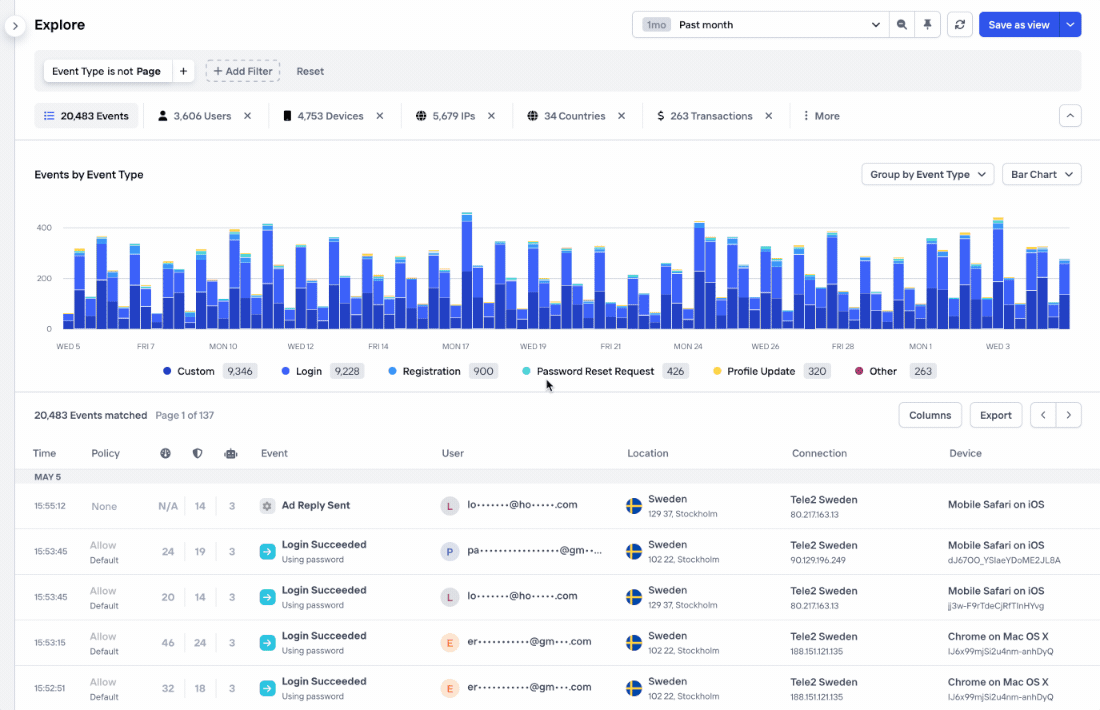In the early stages of a startup, your primary focus is often on growth and development. Goals are set around attracting users, refining the product or service offering, and scaling up in general. During this phase, online abuse can seem like a distant concern, often taking a backseat to more immediate operational needs.
However, as your platform grows and the user base expands, the issue of abuse starts to surface. It might begin with minor instances like occasional spam messages or a handful of rogue accounts. But over time, these issues can escalate, slowly consuming the precious time and resources of the Engineering and Operations teams.
Increasingly, as abuse becomes a drain on your resources, implementing measures such as rate limiting, CAPTCHAs, or safeguards against repeated signups from the same device fingerprint becomes essential. What starts as a series of tactical responses soon evolves into a team-wide effort, with each department contributing its unique skills to combat abuse.
The Escalation of Fraud and the Call for Specialization
As your startup expands and acquires users, it unfortunately also attracts more nefarious activities. The severity of abuse issues escalates, and the platform now attracts more seasoned offenders engaging in fraudulent activities. The platform isn't just dealing with spam anymore: unauthorized transactions, account takeovers, and potential financial losses become a concern. It's no longer a matter of reacting against abuse; it's a full-fledged battle against fraud.
So where does abuse end and fraud begin? And what happens when someone gets hold of a user's account for unauthorized transactions? These complex hybrid issues call for a specialized Fraud Team equipped to detect, mitigate, and prevent fraudulent activities systematically. Fraud managers & analysts will have experience looking for odd patterns in big data and establishing automatic mitigation strategies such as triggering additional verification based on enriched user data or scores.
However, forming a Fraud Team doesn't absolve other teams of their responsibilities. Combating online fraud and abuse remains a collective effort, where each team plays a vital role. Support continues to interact with users, providing valuable feedback for further improvements. Engineering and Security work closely with the Fraud Team to stay ahead of the curve and refine the platform's features and security based on the latest trends in fraudulent behavior.
Fraud vs. Abuse
Fraud can often be easier to handle because it involves activities with clear, objective identifiers that algorithms can pinpoint as malicious, for example well-defined e-commerce checkout flows with structured payment and shipping data. However, abuse poses a far more formidable challenge. Its evolving nature and varied manifestations make it feel like an unending game of whack-a-mole. Additionally, since abuse doesn't necessarily involve illegal activities, it can be much harder to clearly define what's right or wrong. For instance, the definition of "abusive" levels of account sharing varies considerably across different services. While an e-commerce site may overlook such sharing, a subscription-based SaaS may have different thresholds for what constitutes acceptable sharing, e.g. limit an account to 5 simultaneous IP addresses and 3 device fingerprints. These thresholds can then prompt locking an account and nudging an upgrade to purchase more seats.
Abuse is complex, and it gets even trickier when you account for its unique nature across different platforms. This makes training machine learning models a bit of a challenge. But a rules-based approach to identify and counter diverse abuse patterns can be a powerful tool to quickly respond to emerging threats.
In a rules-based system, guidelines can be established to address a variety of abuse patterns. For example, if a user is sending an unusually high volume of messages, that could indicate spamming and trigger a corresponding rule. Similarly, if a user repeatedly creates new accounts from the same IP address, a rule could flag this as potential multiple account abuse.

One of the greatest strengths of this approach is its adaptability and speed. When new forms of abuse emerge, new rules can be formulated, tested, and implemented quickly. It's crucial to have the ability to efficiently brainstorm ideas leveraging existing user data to nail down criteria that pinpoints the abuse without affecting genuine users, and to conduct comprehensive backtesting on historical data to reassure the Product team that conversion rates won't be jeopardized. Furthermore, artificial intelligence can enhance this system through effective management and logic optimization.
Centralizing Efforts
For growing startups, online fraud and abuse are a double whammy. These threats never keep still—they evolve side by side. That's why it's crucial to stay one step ahead with a dynamic and comprehensive strategy to thwart them effectively.
To overcome this hurdle, think about centralizing all your data and decision-making onto one platform. There is some debate on whether you should build it in-house or buy it – but as long as you give this step enough priority, it'll speed up your fraud prevention efforts. Centralization fosters collaboration and allows all teams to work off the same data and powerful rules engines. When you're considering platforms, make sure they'll help you consolidate customer data and decision logic across the whole app journey, from sign-up to transaction. We often see product analytics platforms like Amplitude and Mixpanel being used for this purpose, but the issue is that they lack the ability to get a real-time response needed to block fraud and abuse before it happens.
Collaborating and taking a unified, data-driven approach enables your startup to tackle the surge of fraud and abuse that comes with growth. Your ultimate goal is to protect the trust of your users and maintain a seamless user experience that avoids frustration. These strategies and the core values of unity and adaptability should form the foundation of your journey towards a secure, abuse-free online environment. Why not try Castle, a fraud and abuse prevention solution that comprehensively covers all types of malicious activities and streamlines teamwork under one roof?


